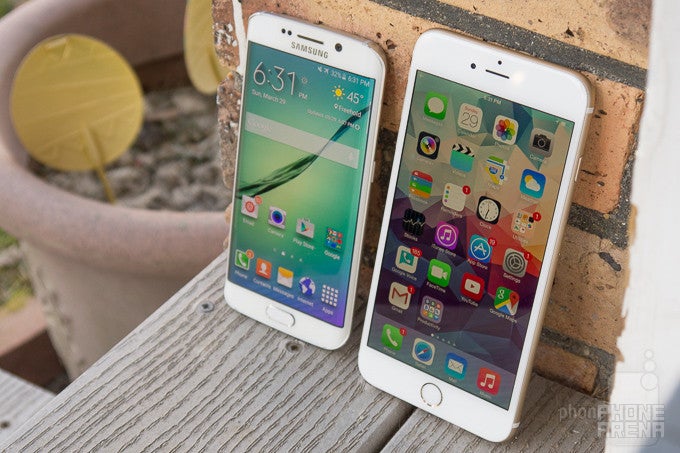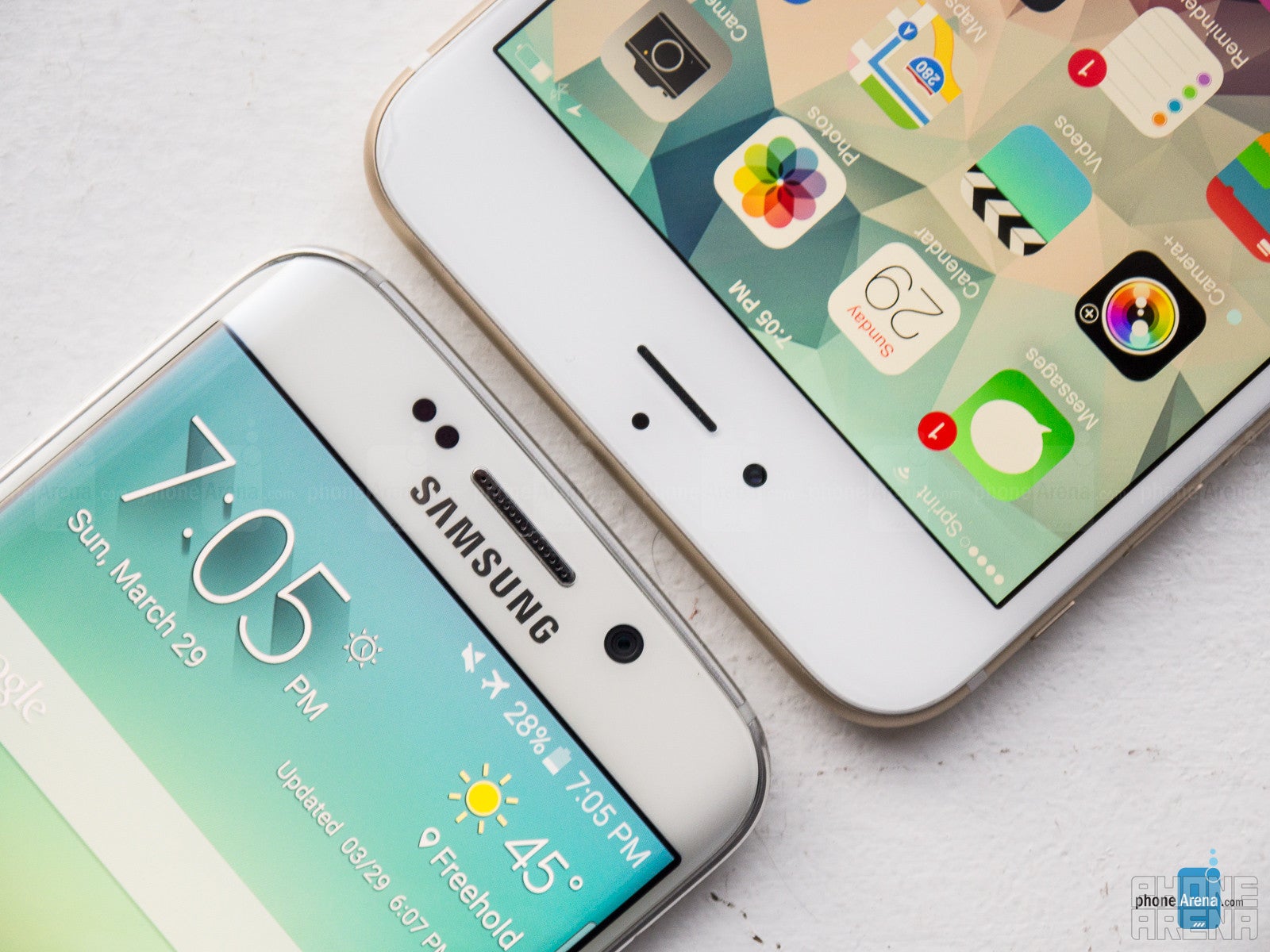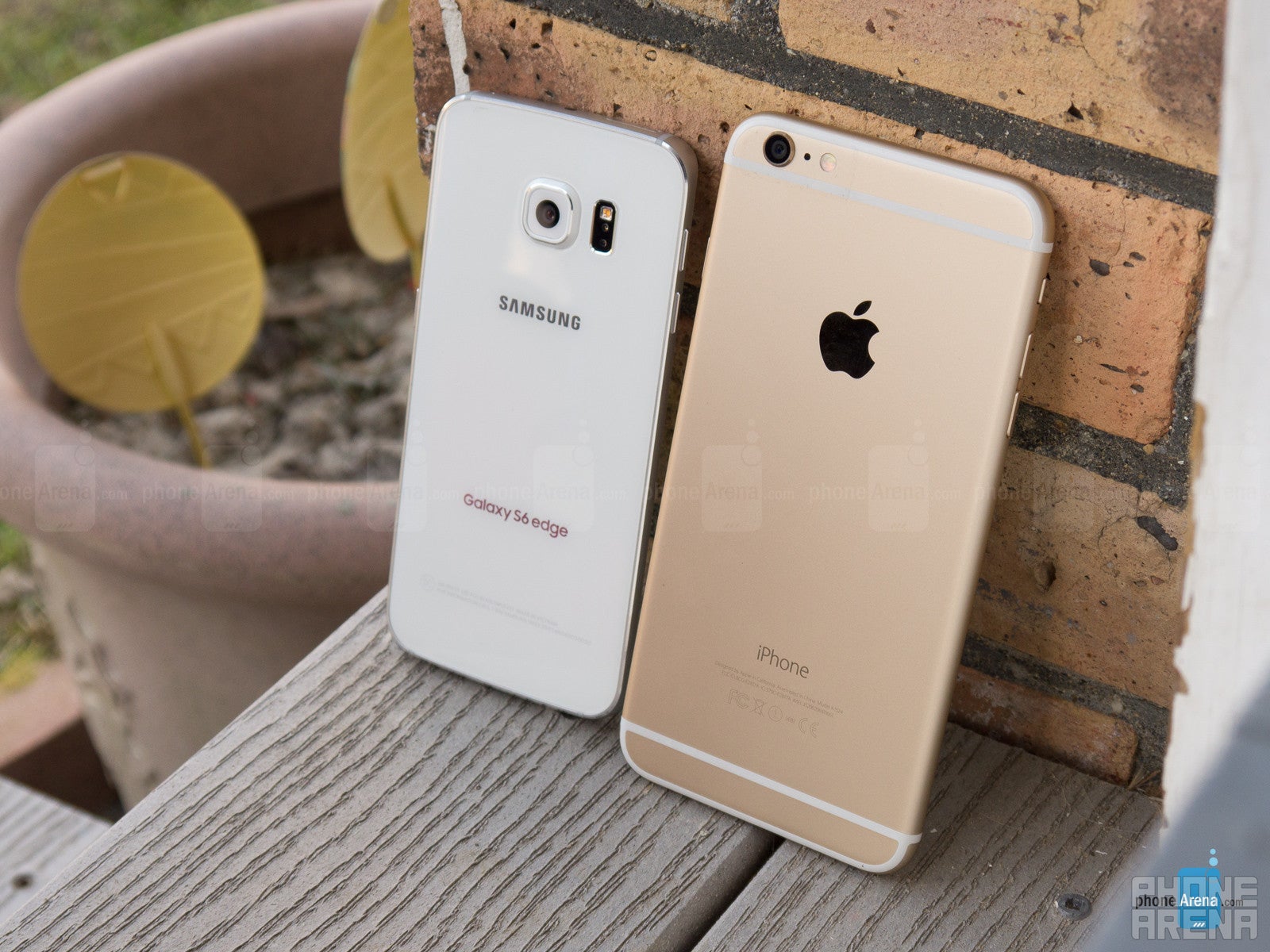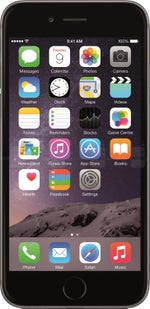Samsung Galaxy S6 edge vs Apple iPhone 6 Plus

Introduction
Undoubtedly, the Galaxy S6 edge is the more captivating member of Samsung's 2015 flagship line. Boasting the same specs as the more mundane Galaxy S6, the S6 edge, with its side-sloped display, is certainly a head-turning phone, probably the most advanced one Samsung has made to date.
However, the S6 edge will inevitably also clash with the Apple iPhone 6 Plus, the most feature-packed iPhone that Cupertino has in its small, but devastating arsenal. Let's see how these two fare against one another!
Design
Samsung has always taken flak for its decision to remain loyal to plastic – fortunately, it was in mid-2014 when the South Korea giant decided that it's time to employ more premium materials in its phones, starting with the Galaxy Alpha. The Galaxy S6 edge is undoubtedly among the most beautiful and classy smartphones Samsung has ever made, in stark contrast with all the preceding plastic offerings from the S line. At the same time, the design of the iPhone 6 Plus is a gradual evolution over its past reincarnations, a polished and perfected vision of the company's design language.
The exterior of the Galaxy S6 boasts a metal frame with slightly-chamfered side edges, complemented by a rear cover made of Gorilla Glass 4 that further adds to the premium status of the new Galaxy. This puts it in a similar league like that of the iPhone 6 Plus, a device that also boasts a hefty amount of premium in its build – it's also an aluminum warrior that employs curved edges in its intricate design. Its display is a flat one, but the glass that covers it is slightly curved towards the edges.
Still, the Galaxy S6 edge does not sit as comfortably in the hand as the iPhone, mostly due to the sharper, slightly uncomfortable feel of the metal edges. In contrast, the iPhone feels better due to the rounded aluminum body of the handset. However, the latter also feels a bit slippery due to its aluminum back. In contrast, the glass rear cover of the S6 edge is less prone to sliding. Unfortunately, it's also way more susceptible to holding fingerprints and smudges than the iPhone 6 Plus.
Despite sharing a few common design aspects (the bottom-positioned speakers, the protruding cameras, and similar hardware button configurations), the Galaxy S6 edge and the iPhone 6 Plus stay true to their roots and are full-blown representatives of the design languages of their respective makers.
Display
Despite employing fundamentally-different display technologies, both devices have equally-impressive screens, ones to lo and behold. Samsung has once again outdone itself with the 5.1” Super AMOLED display on the Galaxy S6 edge. In its Basic mode, it's undoubtedly among the most color-accurate displays out there; it's also one of the sharpest ones thanks to the ultra-high resolution of 1440 x 2560 pixels, which commands a staggering pixel density of 577ppi. This time around, we can only applaud Samsung for the display it put in the Galaxy S6 edge.
The iPhone 6 Plus is also equipped with a respectable screen – it's a 5.5” IPS LCD one with a resolution of 1080 x 1920 pixels. As such, it's not only the largest display ever fitted in an iPhone, it's also the sharpest with a pixel density of 401ppi. Although it's quite hard to discern individual pixels on either the Galaxy S6 edge or the iPhone 6 Plus, we can't ignore the fact that the Samsung flagship has a sharper and more accurate display. With a color temperature of 6800K, the S6 edge is more balanced than the iPhone 6 Plus.
In its Basic screen mode, the display of the Galaxy S6 edge is one of the more accurate ones we've ever seen. Our display measurements reveal that its various nuances and shades all match their desired sRGB targets closely. The iPhone 6 Plus is trailing in this aspect – despite being pretty close to the reference points on the color chart as well, it does not represent all colors as precisely as the Super AMOLED display in the S6 edge, and has a slightly colder tone to it.
As far as brightness is concerned, you'd hardly have any issues with viewing them in bright daylight. The iPhone 6 Plus achieves a maximum brightness of 574 nits, while the Galaxy S6 edge provides a marginally-lower output of 563 nits.
Interface and functionality
The Galaxy S6 edge and iPhone 6 Plus are two new chapters in the eternal clash between Android and iOS. The new Samsung flagship runs on Android 5.0.2 Lollipop with a slightly toned-down, less-bloated reincarnation of Samsung's TouchWiz UI atop. Don't get us wrong, though – TouchWiz is still TouchWiz, so you'll still encounter things like Multi-window, One-handed mode, Screen pinning, and Smart Lock.. System-wide theme support is also among the noteworthy new features.
Running iOS 8.2, the large iPhone provides you with a straightforward and cohesive experience. True, the iOS-running iPhone does not flaunt as many features as the Galaxy S6 edge, but some of the new ones that arrived alongside the latest major refresh of iOS, iOS 8, are pretty notable, for example widget and third-party keyboards support, as well as the useful Reachability. There's no denying that the Galaxy S6 edge is more feature-rich, but the iPhone 6 Plus is undoubtedly more straightforward and intuitive.
Similar to the Galaxy S5, the Galaxy S6 edge has a fingerprint scanner embedded in its home button; this time around, it's a touch, not swipe one. The iPhone 6 Plus also has such a scanner in its home button.
Although it's not as functional as the auxiliary screen of the Note Edge, the display of the S6 edge comes in handy when you need to access quick contacts, notifications, and information from a limited amount of apps, and... that's pretty much it. Oh, and we shouldn't forget that both sides of the display can flash in a pre-configured color when you receive a phone call from a certain contact and the screen is face down. Still, we wouldn't say that iPhone 6 Plus users are missing much here.
Processor and memory
Clicking and ticking inside the Galaxy S6 edge is a 64-bit octa-core Exynos 7 Octa 7420 chipset that is swearing by the ARMv8 instruction set and the 14nm FinFET LPE manufacturing process. Its CPU flaunts four Cortex-A57 cores that can go all the way up to 2.1GHz and another four Cortex-A53 ones that are clocked up to 1.5GHz. The iPhone 6 Plus, on the other hand, is powered by a 64-bit Apple A8 SoC, which comes with a 1.4GHz dual-core Cyclone processor on board. The Apple A8 chip is built on a 20nm manufacturing process and is said to be 30% faster and 25% more energy efficient than its predecessor, the Apple A7.
As far as synthetic benchmarks are concerned, the iPhone 6 Plus seemingly has the upper hand in single-core performance, wheres the Galaxy S6 shines in multi-core tests. However, this has little to do with real-life performance: both devices feel snappy, with no lag whatsoever, and you'll always be aware that you're indeed using a flagship smartphone. Yet, the iPhone 6 Plus has the upper hand in graphics-intensive games, where it performs better than the Galaxy S6.
In terms of RAM, the Galaxy S6 edge comes with 3GB of operational memory and overshadows the iPhone 6 Plus, which only has 1GB of the precious hardware commodity. Both phones slightly differ in terms of available storage options as well – 32, 64, 128GB for the Samsung and 16, 64, or 128GB of native storage in the iPhone. Unfortunately, we have no microSD card slot in the Samsung flagship, which has always been one of the traditional features of almost all previous Samsung handsets, but at least we have ultra-fast eMMC 5.1 flash memory on board.
Internet and connectivity
True to their flagship statuses, both the iPhone 6 Plus and the Galaxy S6 edge provide their users with an A-class browsing experience. Due to the larger screen estate, the iPhone may be a tad better in this regard, but the intriguing Samsung with its stunning display should not be overlooked. From the get-go, the Samsung flagship allows you to choose between two browsers – the default Samsung one and Google's Chrome. Apple enables you to surf the web with the signature Safari, but of course, you can freely download third-party browsers on both devices as well.
The Galaxy S6 is fitted with an LTE Cat.6-capable modem, which supports theoretical transfer speeds of up to 300Mbps. The iPhone 6 Plus comes with an LTE Cat.4 modem, which only supports data transfer speeds of up to 150Mbps. We also need to mention that similarly to the iPhone, the Galaxy S6 edge comes with a nano-SIM card slot – it's the first Samsung flagship to do so.
Camera
The Galaxy S6 edge is fitted with a camera similar to the one that appeared on the Galaxy Note 4 (a 16MP one with a 1/2.6” Sony Exmor IMX240 sensor); this time, however, Samsung has pumped up the maximum aperture to f/1.9, which allows more light to hit the sensor and potentially improves low-light performance. We also have optical image stabilization on board. The camera app has a multitude of different modes on board: auto, selective focus, panorama, slow motion, fast motion, virtual shot, and manual control. It's worth mentioning that the camera app opens up blazing fast; you can also launch it by double-clicking the home screen.
The iPhone 6 Plus, despite donning only an 8MP camera at the back, is also among the best camera-phones out there. It's equipped with a five-element lens that has an aperture of f/2.2 and a sensor with a so-called “Focus Pixel” auto-focus system that allows it to also focus in fractions of the second. The large iPhone also has OIS in its specs sheet. Its camera app is more streamlined, but also comes with some notable modes, like time-lapse, slo-mo video, square photo, and panorama.
In terms of image quality, we have two well-prepared rivals inside the boxing ring. The camera of the Galaxy S6 edge produces spectacularly-looking and ultra-detailed photos that have just the right amount of sharpness and color fidelity. Unsurprisingly, the camera performs spectacularly in daylight conditions, but it also impressed us with its image quality in low-light environments. Thanks to the f/1.9 lens and OIS, night-time shots turn up with a good amount of detail and white balance level, while not adding much undesired noise to the resulting images.
The iPhone 6 Plus is also a stunning device for mobile photography. Respectable amount of details (though not as much as the Galaxy S6 edge), correct exposure, and proper color reproduction is what you get from the rear camera. Still, it's worth mentioning that the iPhone produces warmer images. Almost no noise is visible in the images taken with the iPhone 6 Plus. In poor lighting, the camera of the iPhone 6 Plus does not exhibit as much details as the Galaxy S6. We also have to commend its low-light performance, which might not be as good as the one of the Galaxy S6 edge, but is still among the best on the current batch of smartphones.
The Galaxy S6 edge is able to record UHD and QHD clips, as well as 1080p at either 60 or 30fps. Slow-motion videos (120fps at 720p) are also part of the mix. Smooth and rich in details videos is what the Galaxy S6 will treat you to; the extremely fast continuous auto-focus is also a pretty notable feature. The iPhone 6 Plus, on the other hand, enables you to shoot 1080p video clips, 120fps 720p ones, and even ultra slow-motion, 240fps videos (once again at 720p). In particular, 1080p videos taken with the iPhone are smooth and a bit less noisy than the ones taken with its adversary; the Apple device also produces noticeably warmer videos.
Multimedia
Yes, multimedia is yet another theater of war for the Galaxy S6 edge and the iPhone 6 Plus. Up until now, Galaxy flagships have always had larger displays than the contemporaneous iPhone generation, but this is no longer true. The iPhone 6 Plus now comes with large, 5.5” IPS display that's perfect to watch video on.That being said, the Galaxy S6 edge is also a rather suitable device for multimedia viewing, despite the fact that it's donning a smaller display. Media content looks especially snazzy on that Super AMOLED panel.
In terms of audio, the iPhone 6 Plus has the upper hand. It produces deeper, more profound sound from its bottom-firing loudspeaker. The Galaxy S6 edge is not sub-par in this regard, but it simply can't match the depth of the iPhone; sound is a bit subdued and thin. Both perform well, but we'd choose the iPhone 6 Plus over the Samsung device.
Call quality

Battery life

The Galaxy S6 edge also shines in terms of charging speed, as it can get fully charged in 83 minutes (thanks to the on-board fast-charging feature), which is an extremely good result. Meanwhile, the iPhone 6 Plus will has to stay plugged for 171 minutes in the charger in order to get charged from 0% to 100%. Oh, we should also mention that the S6 edge comes with built-in wireless charging.
Conclusion
We can't deny that both the Samsung Galaxy S6 edge and the Apple iPhone 6 Plus are two of the better, if not the best smartphones in the world right now. Both are extremely polished and designed with a pretty intricate attention to detail. The Galaxy S6 edge is certainly the ultimate embodiment of Samsung's engineering and design prowess.
Its notable adversary, the iPhone 6 Plus, is an equally impressive device that is by no means a sub-par smartphone. Yes, it's true that each device has its own strengths and weaknesses, but we can't deny that each is a masterpiece on its own. Hence, choosing one over the other will be mostly a matter of personal preference, especially since we're comparison two devices of considerably different proportions.

Samsung Galaxy S6 edge
Pros
- More compact dimensions
- Non-slippery back
- More color-accurate display in Basic mode
- Fast charging
Apple iPhone 6 Plus
Pros
- Bigger screen
- Doesn't hold any fingerprints
- Super intuitive user interface


























Things that are NOT allowed: